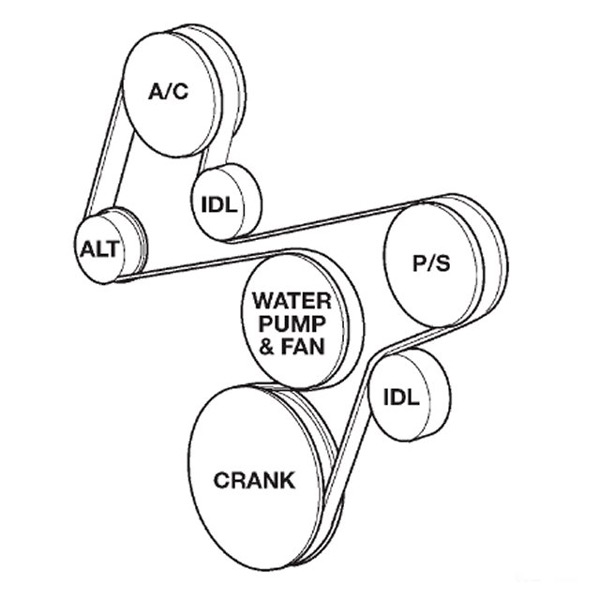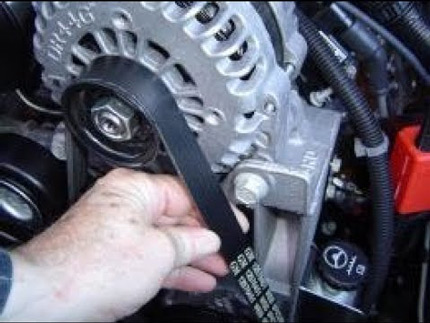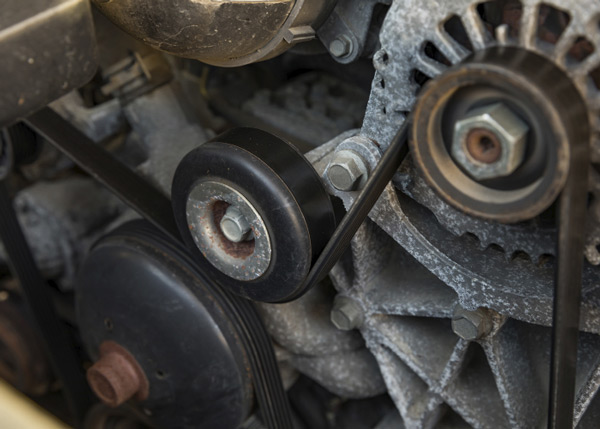The serpentine belt is a long winding belt that allows the alternator, power steering pump, air conditioner, and in some cases water pumps to run smoothly and efficiently
If you are old enough to remember the good times when you replaced the fan belt, you may also remember the bruises and knuckle curses that followed. To make matters worse, it is often necessary to replace two or three belts. Now, most cars no longer use a separate belt for each piece, but instead use a wider, multi-slotted “serpentine belt” because it has multiple pulleys. The name is meandering. The serpentine belt is easy to replace because today’s automatic drive belt tensioners do not need to loosen bolts or pry components to re-tension them. Just turn the tensioner, remove the old belt, and install the new belt. When the belt rib is in place in the groove of the pulley, the tensioner is released to complete.

What is serpentine belt?
The serpentine belt gets its name because it winds around the pulley in the engine compartment. This long, curly rubber belt powers many important systems of your vehicle by transmitting power from the engine crankshaft to the accessory pulley. These pulleys rotate to drive components such as alternators, power steering pumps, and air conditioners. In some cars, it even powers the water pump of the cooling system. The serpentine belt is a long winding belt that allows the alternator, power steering pump, air conditioner, and in some cases water pumps to run smoothly and efficiently.
What are the symptoms that my vehicle’s seat belt may need to be replaced?
Squeaking or Squealing: When the belt begins to slip, it may make a squeak. This is due to improper belt and pulley operation, low belt tension, or belt stretching and / or wear. Oil and antifreeze leaks can also cause belt slippage. If you hear these sounds, you should check your vehicle as soon as possible before further breakdowns occur. With this voice, they will eventually.
System performance loss-The power steering may be malfunctioning, the battery may suddenly run out, or the engine may just stall. All of these are controlled by a functioning serpentine belt or V belt.
Once your belt is damaged, it will further damage important systems that depend on it, such as alternators, water pumps, power steering, and air conditioning. Unfortunately, the resulting damage may require extensive repairs, and there is little warning before the incident.
Check Engine Light Illumination – This may indicate a problem with the belt. An interesting noise may be related to problems with other components. Never ignore the noise. Where there is noise, there are potential problems. Check your driving and protect your investment on all four wheels.
What happens when the belt ages?
They will wear, fray, crack or become shiny or “glazed” and rubber parts will fall off the belt. An aging belt may also start to slip or squeak, be contaminated with liquid, or be out of position, in which case it needs to be replaced. The old belt may even break, causing you to go upstream; if not, all the torque of the engine accessories will be lost.
What is the benefit of replacing the belt?

Driving with an old belt is a disaster waiting to happen because it powers most engine parts. This means that when your belt breaks, slips, and eventually wears out, everything from the power steering pump to the alternator to the air conditioner will stop working. More importantly, the components you control can be seriously damaged. Broken hoses and belts are bad; damaged engines are even worse. By changing the belt regularly, you can minimize the risk of failure. The hat is a “belt tensioner”
What are the benefits of replacing it when replacing the belt?
Many vehicles today are equipped with self-tensioning devices called automatic seat belt tensioners. These tensioners are designed to maintain a predetermined tension on the serpentine belt to make it work properly and keep your car moving. Your winding belt is like a huge rubber band, spinning very fast. And, just like a rubber band, you must maintain a balance of flexibility and tension. Most tensioners have an internal spring and pulley that apply enough force to the serpentine belt to keep it tight. If there is not enough tension, the belt may slip, squeak or become hot. In the worst case: a loose belt may fall off the pulley. When this happens, all accessories running on the engine will be closed and the vehicle will stop running.
How to replace your Serpentine Belt
Note Belt Accessories
The serpentine belt has this name for a reason. They enter and exit a series of pulleys and peripherals, and the path they travel is unique to your car model. In order to maintain the position of the belt, take a few snapshots from different angles or draw a picture of how it is wound on the motor. If the seat belt has been misplaced, please check the driver’s manual or poster under the hood for a sketch of the route.
Loosen and unwind the belt
Before removing the belt, you must loosen the tensioner, which automatically keeps the belt tensioned while driving. Turnbuckles typically have one of two ways of releasing tension. Many have a ½”square mold on the tensioner arm, into which you can insert a ½” breaker bar or belt tensioner tool to reduce tension. For many others, use the pulley bushing to do this. Use a ratchet or a suitable broken rod for the bolt and loosen the tensioner. Then carefully unbuckle the belt, being careful not to interfere with or damage the pulley network and peripheral equipment.
Check for damage

After removing the belt, check for signs of damage. Many belts wear out over time, but some belts do wear out due to misalignment or other problems. When replacing the belt, the misalignment will not resolve itself, so please determine if this is the problem. Look for decomposition along the edges and separated ribs, which are signs of misalignment in your hands. Use a ruler to ensure that the pulleys are aligned correctly, and then wipe off the old dirt and dirt on the pulleys. This is also a good time to check for oil spills. Oil will increase the wear of the serpentine belt.
The most important thing is to put idlers and idlers (they are pulleys that don’t drive anything, such as power steering) and give them a turn. Listen carefully. They should be able to rotate freely and make no noise. Grab each pulley and check for any left-to-right or in and out movement. Any excessive movement or noise of any of these pulleys must be replaced. If these pulleys fail on the vehicle, your belt will fall off and run without a water pump, power steering, and alternator, so check them carefully!
Installing a new belt
Replacing a serpentine belt is very simple, just snap it into place, rotate the tensioner, and then slide the belt over the nearest idler or upward pulley. The belt tensioner is mainly spring tensioned. After installation, the spring will maintain pressure on the strap. Once opened, make sure that the belt is fully installed and placed very carefully in the center of each pulley. Then start the engine. Let the engine idle for at least 60 seconds to ensure that the serpentine belt works properly. Replace any other parts or covers that you removed before driving the vehicle. Replacing the serpentine belt is an important part of daily automatic maintenance, but it is not difficult.
How long can the serpentine belt last?
The serpentine belt can be used for many years and may only need to be replaced once or twice during the life of the vehicle. The recommended industry standard is to check your belt for wear at 60,000 miles and replace it if necessary, and replace it every 90,000 miles, regardless of appearance, to reduce the chance of failure. Like anything else on your vehicle, it is not indestructible and will eventually fail. If your car has been used for long enough, or it is an old model, be prepared to replace it, as the belt will be affected by heat and friction over time. The best way to determine when to replace it is to check the maintenance interval in the user manual.
What should I do if the belt is broken?
If you’re like many other drivers, when a part or system fails, you may have driven farther than you should. With certain components, you can keep the car on the road for a period of time. However, if your serpentine belt breaks or falls off completely, you will have no choice but to replace it. When your belt fails, everything you drive will stop working. In most cases, these are the alternator, the water pump, and the power steering pump.
Usually the first thing you feel is a lack of power steering. When your alternator stops working, the battery light will also come on. Eventually, your engine temperature will rise rapidly because your water pump has stopped working. The moment you understand any of these symptoms, it is very important that you stop immediately! If you are not on the road, quickly drive your vehicle to a parking space away from congestion.
If you are sure that your seat belt has broken, you will not be able to drive the vehicle any further. The vehicle will overheat in a few minutes, at which point you can risk twisting your head, breaking the cylinder head gasket and damaging much more than a trailer.
Belt Replacement Cost
If your serpentine belt is broken, feel free to replace it with a new one. This will give you peace of mind and get you back on the road safely. Imagine that next time you buy a belt; it may be the last time you have to do it on that car. More good news: Compared with other auto parts, serpentine belts are cheaper. Professional mechanics usually charge $75 to $120 in labor costs to remove old belts and replace them with new ones. If you are considering doing this work yourself, make sure you understand the process. You don’t want to drive with a serpentine belt that is not installed correctly. If you need help changing your belt, look at the list of local preferred stores in your area. When you are sitting in the driver’s seat of a vehicle, you may not spend a lot of time thinking about serpentine belts.
Wrapping up
As you learn more about how this rubber component powers your vehicle, you will begin to appreciate it even more. Keep your eyes and ears out and watch for signs of damage to the belt so you know when to take it off and put on a new belt. Then you can continue to drive safely and the reliability of your car will be improved.
